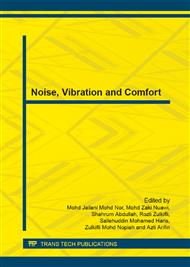p.89
p.97
p.102
p.107
p.113
p.119
p.125
p.130
p.138
Parametric Study of an Electromagnetic Energy Harvester
Abstract:
This paper presents two important parameters for an electromagnetic energy harvester exploiting various shaker excitation frequencies: (1) number of turns of the coil and (2) length of the beams for the device. This system consists of a cantilever beam based which represent a spring element of the system, permanent NdFeB magnet, coil system and wiring system to be connected to the data acquisition system. It is found that the induced voltage is proportional to the increment of the number of turns and the length of beams. The expected resonance happens at 300 Hz for case (1) and 100 Hz for case (2). The maximum voltage produced by this device is 915.395 millivolts for length 13 cm at 100 Hz excitation and 275.058 millivolts for 1050 turns at 300 Hz excitation. Experimental data have demonstrated that the geometry and number of turns of the coil would affect the performance of the energy harvester while excitation frequency as a non-physical factor also contributes to its effectiveness.
Info:
Periodical:
Pages:
113-118
Citation:
Online since:
December 2013
Keywords:
Price:
Сopyright:
© 2014 Trans Tech Publications Ltd. All Rights Reserved
Share:
Citation:


